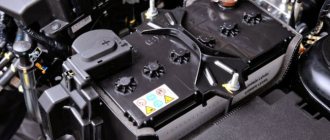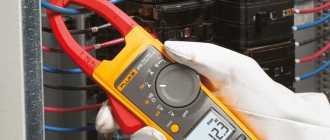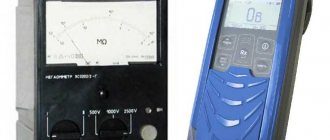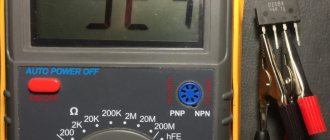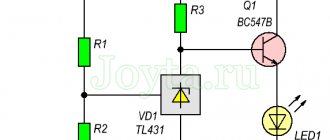A multimeter is a universal device for accurately determining voltage, current or resistance and more. Using even inexpensive Chinese models allows you to effectively test any type of battery. This article will describe the basic ways to use the tester to determine battery health.
Which batteries can be tested with a multimeter?
All types of batteries are characterized by parameters such as capacity, current or voltage, so using a measuring device you can easily check any battery for performance.
Most often, due to its widespread use, it is necessary to measure the performance of car batteries, Ni-Cd, Ni-MH, Li-Pol and Li-Ion batteries in this way.
Even if a car or gadget is equipped with standard programs for measuring battery charge, in many cases, such utilities show general information about the amount of charge. At the same time, the accuracy of such utilities cannot always be trusted.
How to check the starting current of a battery with a multimeter?
There are many different types of electrical-related car breakdowns. And, probably, everyone has encountered an unexpected battery discharge after a night of parking in the cold or even in the warm season. But the cause of this condition is not always a battery failure. To determine this, you need to learn how to correctly measure the battery current, but how to check it and get an adequate assessment?
The starting current is the main indicator that indicates the energy characteristics of the source. If it is too low, the battery will not be able to turn the starter with the required force. You can check the performance of the battery not only with the help of special testers. As you know, such devices are expensive, and not every car owner is able to buy one. But checking the battery with a multimeter is quite possible.
Checking battery parameters using a multimeter
To carry out measuring work, in many cases, it is impossible to do without dismantling the battery. If it is necessary to test a car battery, it should also be removed from the car.
Voltage
All batteries produce direct electric current at the terminals, so to measure it, the multimeter mode switch should be set to the DC position. The battery voltage can differ significantly depending on the type of battery, so in order to get the most accurate readings, you must correctly select the maximum voltage that the device can measure.
The multimeter switch has several modes that can be used to measure DC voltage. For most batteries, it is enough to set the limit to 20 V. Almost all AA batteries and phone batteries are capable of delivering significantly lower voltage.
The only exception to this rule is the measurement of 24 V car batteries, and some laptop batteries, which, when fully charged, can have a voltage exceeding 20 V at their terminals.
Note. In the same way, you can measure the voltage in industrial batteries or in an outlet, only in this case you need to switch the switch on the multimeter to a higher voltage, for example 200 V.
When measuring, it is important to maintain polarity, that is, connect the red probe to the battery positive, and the black probe to the negative. When reversing the polarity, devices equipped with a digital display will inform you about the polarity violation with a minus sign in front of the number.
On pointer instruments, such a connection will cause the needle to move in the opposite direction, which will completely prevent correct voltage measurements. Although in general there is nothing wrong with this.
Current strength
In order to measure the current strength of a low-power battery, it is enough to switch the device to the mode for measuring this parameter (A). By touching the probes of the device to the battery terminals, you can get the exact value in milliamps.
When taking measurements on a battery of higher power, the device is switched to the “10A” position, and the positive output of the multimeter is moved to the adjacent cell.
If you need to measure the current on a car battery, then these two methods are not suitable, because the discharge current of such batteries can reach several hundred amperes. Such measurements can only be carried out using a special tester, for example, Bosch BAT-131.
Capacity
Using a multimeter, you can approximately calculate the actual battery capacity. In addition to the tester, you will need to assemble or purchase a voltage stabilizer, which must correspond to the rated voltage of the battery.
Then you should select a load that can be powered from the battery for a sufficiently long period of time. To calculate the capacity, you should also prepare a stopwatch.
The measurement process is carried out in the following sequence:
- The multimeter is switched to current measurement mode (10 A).
- The measuring device is connected in series to a circuit consisting of a current source, a voltage stabilizer and a load.
- The stopwatch starts.
After turning on the circuit, you should record the values of the multimeter, and use a stopwatch to determine the amount of time it will take to completely discharge the battery. After multiplying the current by the time, you can get the actual battery capacity, measured in amps/hours.
The use of this method for measuring the capacity of many acid batteries is not recommended, due to the negative impact of completely discharging the battery on its performance.
Example! If we know in advance that the device connected to the battery consumes 10 Ah, then depending on how many hours it works, this will be the battery capacity. If in our case the device operates for 10 hours, then the battery capacity will be 100 Amperes.
Internal resistance
Using a multimeter, you can easily measure the internal resistance of a current source. To perform this operation you must:
- Measure the voltage at the battery terminals.
- Connect the load and measure the voltage drop and current in the circuit.
- Carry out calculations using the formula R = U/I, where R is the internal resistance, U is the voltage difference at the battery terminals before and after the load is turned on, I is the current strength in the circuit.
This method is suitable for measuring almost any type of battery.
High leakage current
Leakage current
Measuring the leakage current is very simple. To determine this parameter, you need to switch the multimeter to current measurement mode, connect the negative terminal of the battery to the device, and connect the positive output of the battery to the connected cable through the tester.
The amount of leakage current will be displayed on the digital display. When measuring leakage current on a car, the multimeter should be switched to resistance measurement mode (10 A), and all electrical consumers should be turned off.
Overcharge
To determine overcharge, the multimeter should be switched to voltage measurement mode. After determining the voltage, you should compare the nominal value of the battery with those obtained as a result of the measurement. If the latter are more than 20% higher than normal, this will indicate that the battery is overcharged.
Overcharging a battery is quite dangerous. Acid batteries, in this case, begin to boil with the formation of explosive gas. Lithium-ion batteries may catch fire or explode if overcharged.
Charge level
For many types of batteries, the state of charge is checked by voltage. As in the previous case, you need to know the battery voltage at 100% charge. A fully charged lead battery should have a voltage of 12.7 volts at its terminals.
Read also: Amplifier with microphone input
Fully charged car battery
A complete discharge of the battery will correspond to a value of 10.5 V. It is easy to determine in this way the degree of charge of the battery if the voltage readings deviate from these values.
Similarly, knowing the nominal voltage values, you can measure the voltage with a multimeter to approximately determine the state of charge of a AA battery or battery for a mobile phone or laptop computer.
| Battery voltage, V | Electrolyte density | Battery charge, % |
| 10.5 | 1.06 | |
| 11.3 | 1.07 | 10 |
| 11.5 | 1.10 | 20 |
| 11.7 | 1.12 | 30 |
| 11.9 | 1.15 | 40 |
| 12.0 | 1.17 | 50 |
| 12.2 | 1.20 | 60 |
| 12.3 | 1.22 | 70 |
| 12.4 | 1.24 | 80 |
| 12.5 | 1.26 | 90 |
| 12.7 | 1.27 | 100 |
Purpose and differences of multimeters
A multimeter is an electrical measuring device that combines several functions. Measuring devices of both household and professional grade are available on sale. The significant difference between these classes lies in the accuracy of the results obtained, which ultimately affects the price of the devices. Household-grade devices allow you to measure various quantities over a wide range of values with low accuracy, while professional testers are more focused on a small group of measurements with a small error.
Based on their operating principle, meters are divided into two types:
You can measure battery parameters with any of these types of devices, but a digital multimeter is more popular among car enthusiasts. This is due to the ease of use and a more visual representation of the measurement result, compared to an analog tester.
The operating principle of an analog tester is based on the conversion of the measured signal into current, followed by its visualization in the form of a needle deflection by a certain amount. A digital device, having microcontrollers in its device, converts the received signal into voltage, and after processing it, displays it on the display in the form of numbers.
Pointer type voltammeter
The main element of this type of device is the electromechanical head. Being made in the form of a frame with an arrow and being under the influence of an alternating magnetic flux, it converts the electrical signal that comes through the measuring probes and elements of the device into a mechanical deflection of the arrow. The strength of this deflection is related to the amount of current detected by the head.
The calculation error of this type of device depends on the sensitivity of the measuring head. The probability of a measurement error with a pointer tester is indicated by a number, for example, 0.1 or 2.0, and is called the accuracy class. Thus, a device with a measurement range from zero to 25 volts and accuracy class 1 will be able to determine the voltage value on a car battery with an error of 0.25 volts. The advantage of the analog type compared to the digital one is its inertia and poor sensitivity to external interference, which allows you to check the battery with a tester with good accuracy.
Digital view meter
The operation of a digital voltage meter is based on the use of an analog-to-digital converter (ADC) in its circuitry. This microcircuit is the core of the device, the quality of which largely determines the error of the result obtained.
In addition, the accuracy class depends on the parameters of the radio components in the device, the quality of the implementation of protection from the external negative influence of electromagnetic fields. The main characteristic of this type of device is its capacity. The higher the bit class, the greater the measurement accuracy will be.
For example, if you use a multimeter to test a car battery with a discharge value of 2, the error in the result will be about 10%. The average value for household class devices when measuring constant voltage is only about 0.3 percent.
An important characteristic of a digital tester is the display capacity. This characteristic indicates how many digits the device can display on the screen. For example, when the bit depth is 3 3/4, this means that the largest value of the measurement value will be 3999. It should be noted here that the accuracy of the multimeter does not depend on the bit depth of the screen, which characterizes the quality of the screen.
What determines the starting current of a battery?
We understand the concept of battery starting current and what it means. The main parameters of the battery that affect the magnitude of the starting current: the size of the lead plates and the area of each of them.
Modern battery models can be the same in capacity and size, but have a different starting current.
What does this depend on? From the manufacturer. For example, a Chinese battery in this parameter is inferior to a European power source by at least 30%. But the price of the latter is higher.
Causes of low capacity and insufficient starting current:
- The use of alloys with low-quality additives, instead of purified lead. The production price of such batteries is lower, but the quality remains at the same level.
- Fewer lead plates. For example, if a European manufacturer fits 5 plates into one battery jar, then a Chinese manufacturer can fit only 4. With a smaller number of plates, a larger charging current will be required to restore the capacity of such a battery, and this will reduce the number of charge/discharge cycles.
- Insufficient sealing of the housing. The battery design is based on good sealing, since during operation the car can produce too much charging current, which will lead to boiling of the electrolyte and its loss even through minor cracks.
- Larger internal volume. This is achieved by reducing the thickness of the housing walls. As the internal volume increases, the amount of electrolyte required for proper battery operation increases.
The only way to avoid getting a product with low starting parameters is to buy a battery from well-known European manufacturers. The cost of such batteries is higher, but the price is proportional to the service life, and each manufacturer provides a long warranty period.
Selection and preparation of the device
When deciding which type of multimeter is best to check the battery, users give less preference to pointer instruments. This is due not only to the accuracy class, but also to the difficulty in interpreting the results obtained. Using digital devices is more convenient in terms of preparation for work and visibility of the results obtained.
Before checking a car battery with a multimeter, the tester must be configured correctly. To do this, first check the serviceability of the batteries. If, when you turn on a digital device, a flashing battery icon appears on its screen, this means that the power element needs to be replaced. For a pointer instrument, the signal to replace the power element will be the inability to set the pointer to the zero position. To obtain the correct result, you should not only use the configured device, but also monitor the ambient temperature. The optimal temperature is considered to be 20 degrees Celsius.
Setting up a digital device consists only of correctly selecting the measurement range and connecting the test leads, while an analog device will need to be calibrated before use. So, before measuring the battery capacity, you will need to set the arrow to the zero position. To do this, short-circuit the clamps of the probes with each other and turn the potentiometer knob located on the device body.
If it is not possible to calibrate the device, then simply replace the batteries. Before measuring voltage, the multimeter is also calibrated by turning the zero knob until the needle moves to the mark indicating the beginning of the scale.
What happens if you install a battery with a lower starting current?
Regarding batteries with increased capacity and installing them on a car, it has become more clear. But what happens if you install a battery with a lower starting current on a standard starting unit?
Many car owners make a serious mistake by purchasing a battery with a reduced capacity. They take this step because of the lower price, but the consequences may not be very pleasant. If the battery is not designed for the starting current required to start the car, then the starter will not rotate at the required speed. Without reaching a certain number of revolutions, the engine will not start.
It should be remembered that the battery capacity designation is always located on the front side of the case.
Battery current with reduced capacity can start a car, but only if the temperature around is above zero, and for this you will need to keep the key turned in the ignition for a long time. As is known from the technical literature, prolonged rotation of the starter leads to a sharp reduction in its durability.
Determining battery parameters
Using the tester, you can measure all the main parameters of the battery, namely: leakage current, charge amount, capacity value. By analyzing the data obtained, its performance can be determined with high probability.
Read also: Modification of the drill stand
Thus, a low voltage value, less than 12 volts, means that the battery requires maintenance, for example, replacing the electrolyte. If the battery voltage is below 10 volts and charge-discharge cycles do not help, then irreversible chemical processes have occurred in the battery and its resource has been exhausted. This can also be indirectly indicated by a high leakage current value. It also happens that the battery voltage is normal, about 12.4-13 volts, but when connected to the terminals of a working car, it drops sharply. This behavior indicates a loss of battery capacity.
The following battery states are distinguished:
- 12.6 to 13.2 V - full charge;
- 12 to 12.7 V is normal;
- 11.6 to 12 V - the battery is discharged below the permissible level, it needs to be recharged;
- 11.6 V or less - the battery is completely discharged and will most likely need to be replaced or regenerated.
Pointer testing
One of the most popular analog devices during the Soviet era was a device called a “tseshka”. Devices in this series are distinguished by their reliability and versatility. Due to their great popularity, many models have been released into the market. Therefore, today you can find such devices in good condition. Since the instrument circuits have not changed much, measurements of battery parameters can be considered using the example of using such a tester.
The device is turned on in accordance with the instructions indicated on the outside of the battery retaining cover. To measure the amount of charge on the battery, the switch button sets the operating mode corresponding to the “—” icon. The measurement range switching knob, made in the form of a biscuit device, is switched to a certain value V, exceeding the expected value that can be obtained during measurement.
In particular, for Ts4342 the switch is set to 50 volts. After this, the test leads are connected to the connectors of the tester. The red color of the connector indicates a positive contact, black - a negative one. The opposite ends of the wires (probes) touch the battery with glue, while observing the polarity, that is, plus to plus, and minus to minus.
If the polarity is not observed, the needle will deviate to the left of zero; if this condition persists for a long time, this can lead to damage to the device, so you need to change the location of the probes. If everything is connected correctly, the needle will deviate to the right from zero to a value equal to 6 on the V scale. This value corresponds to the voltage on the car battery equal to 12 volts.
A dial multimeter is also used to check the battery capacity. This testing is performed using a test battery discharge. To do this, the battery is first charged to 100 percent, and then its voltage is measured.
After connecting a 12-volt incandescent lamp with a power of 60 W to it, the time is noted. Such a light bulb creates a load equal to 5 amperes. As soon as the voltage drops by half from its maximum value, the light bulb turns off. Multiplying time and load current (light bulb) will show the approximate battery capacity.
To determine the leakage current, you will need to change the device settings. The switch in the tester is set to the maximum current value. In relation to the Ts4342, this value will be 2500 mA. The positive terminal coming from the car to the battery remains in place, and the negative terminal is removed and connected to the positive probe of the multimeter. The negative probe of the meter is set to the minus of the battery. In this case, everything in the car must be turned off and the key must be removed from the ignition. A value of up to 100 mA indicates that the equipment is working properly. If more, then there is a problem.
Checking with an electronic meter
Measuring a car battery with a digital tester is no different in principle from the pointer type. The multimeter is connected with a pair of wires to the battery. Each wire has a plug at one end that is inserted into the tester socket, and at the other there is a measuring probe.
The sequence of actions when measuring voltage with an electronic multimeter can be presented as follows:
- The device's ON/OFF button is pressed.
- The switch selects a measurement limit exceeding a constant value of 12 volts.
- The wire plugs are installed in sockets V and COM.
- Use the probes to touch the battery terminals and take readings from the multimeter screen.
- When, when taking readings, a “—” sign appears on the screen in front of the result, this indicates that the polarity of the probes is connected incorrectly.
The leakage current is measured at the gap in the negative wire connecting the battery. But before this, the device plug from socket V is moved to the socket marked mA or A, and the switch is switched to current measurement mode.
It is worth noting that it is possible to check a car battery without disconnecting its terminal from the car’s generator. To do this, without turning on the ignition, connect a tester in voltage measurement mode parallel to the battery terminals.
The measurement range is set to about 20 volts. The tester readings corresponding to the normal state of the battery will be in the range of 12.4-12.8 volts. Then the car starts. In this case, the voltage should rise to 14.6−14.7 volts. Such readings indicate the performance of both the battery and the car’s generator.
Thus, using a multimeter, you can measure all parameters of a car battery. After this, making the right decision about replacing or resuscitating the battery will not be difficult.
If you have problems starting your car, you should make sure that it is not related to the battery. The simplest and most effective way to check the condition of the battery is to use a multimeter.
The following sequence of actions can be distinguished when checking a battery with a multimeter:
- We install the device in the required mode. The multimeter allows you to check several indicators, depending on which method is used to calculate the necessary data.
- We set ranges higher than those indicated in the battery specification. Otherwise, it is impossible to measure the necessary indicators.
- The probe, which is black , is installed in the minus socket. All such devices have 2 probes - red and black.
- the red probe to the red socket.
- Within a few seconds, the main indicators are recorded.
- After the necessary data has been received, we disconnect the circuit.
In a similar way, you can check the operation of the battery. However, it is important not only to obtain the data, but also to know what it may mean. An example is the definition of charge. A multimeter cannot measure such an indicator; it must be obtained based on the voltage obtained when checking the circuit.
Battery inrush current - what does it mean?
The starting system of each car consists of a battery, electrical wiring, ignition switch and starter. When you turn the key in the ignition switch, the power wires are connected, voltage is supplied to the relay, after which it goes to the starter. The starter turns the crankshaft and the car starts.
To operate the starter, a rechargeable battery is required, and since this element is a standard electric motor, it will require electric current to create an electromagnetic field in the stator (the stationary part).
When cranking a cold engine, greater effort is required, which means more current. The concept of the current that is necessary for high-quality cranking of the starter and subsequent starting of the engine is called starting current.
What is the starting current of a car battery can be understood from a simple formula: P=UI, where P is power, U is battery voltage (standard voltage is 12 V) and I is electric current. The relationship is simple: if the voltage remains constant, then with increasing power the electrical current should increase, in this case the starting current.
Checking charge and capacity
The battery charge can be checked only by converting the received data from the multimeter. It is recommended to check it provided that about 5 hours have passed since it was disconnected from the car or recharged. This will allow you to obtain more accurate data. It is worth noting that ambient temperature cannot affect the accuracy of the readings.
Read also: DIY metal shelf
When considering the indicators, we note the following pattern:
- A voltage of 12.8 V indicates that the battery is fully charged. This value may even be slightly higher. However, a significant excess indicates serious malfunctions.
- The indicator 12.6 V corresponds to 75% charge.
- Voltage 12.2 V - The battery has only half a charge.
- 12 V on the multimeter indicates a 25% charge.
If the voltage in the created circuit is less than 12 V, then the charge has dropped below 25%.
Another important indicator is the battery capacity.
You can check the capacity as follows:
- should be fully charged.
- In order to obtain the necessary data on the battery , you need to apply a load, for which you can connect several car headlights into one circuit.
- A dim glow with a reading less than 12.4 V indicates that in winter there may be problems with starting the car.
- If the indicator drops below 12 V , then the battery should be replaced.
Multimeter indicators
A multimeter is a popular tool not only for motorists. It is used in any area where it is necessary to measure current: voltage, resistance and its strength.
Its versatility is characterized by the fact that the device includes the following:
- Voltmeter.
- Ammeter.
- Ohmmeter.
The device is compact and can be easily carried and stored in a car. Thanks to constant use to check the condition of the battery, it can be maintained in working condition for a long time.
There are several versions of such a device.
When choosing it, it is recommended to pay attention to the following:
- measurements are carried out ranging from 0 to 200 mV, as well as 2 V, 20 V, 200 V, 1000 V.
- DC current can be measured within 2 mA, 20 mA, 200 mA.
- The alternating voltage ranges from 0 to 200 V, 750 V.
- Resistance can be measured from 0 to 200 ohms.
There are more complex versions of the multimeter.
How to measure cold cranking current using a universal tester?
To make objective measurements of the amperage produced by the battery in a car, you need to perform the following steps:
- Find an equivalent load, the maximum current through which, according to calculations, will not exceed the limit of the device in the desired mode. Let's say you use a device with a maximum mark on the panel of 20 A. You need to select a resistance such that when turned on it would not be greater. The battery produces a voltage of 12-12.7 V. To obtain a reading current equal to 10 A, you need to connect a load with a resistance of 1.2-1.27 Ohms.
- The resistor is connected to the car battery in series with your device.
- Preliminarily switch the measuring device to current control mode. If you don’t know, the panel will have the letter “A” written on it and numbers indicating the limit. Switch to the largest one. Also select ADC mode, that is, direct current measurement.
- When connecting to the battery, pay attention to the polarity of the probes. Red is always a plus; it must be included in the socket, near which there is a designation of limits and the measured physical quantities are indicated. Black is negative and is connected to the socket labeled “COM”, there is a ground icon next to it.
A series connection is a circuit in which all components are connected in one line. Current flows through all devices, and its strength is determined by the total resistance.
Battery voltage measurement
An important indicator of a battery is its voltage. That is why many measure this particular indicator.
With the engine running, it is possible to measure the voltage. A normal voltage is considered to be between 13.5 and 14 V. But a voltage above this value when the engine is running indicates that the battery is low charged and the voltage regulator supplies more energy from the generator to charge it. It is worth considering that this is a common occurrence in winter, since the battery can be seriously discharged overnight.
An increase in battery voltage is a phenomenon that you should not be afraid of. If everything is in order with the technical condition of the vehicle’s electrical equipment, after 10 minutes the voltage indicator will stabilize and will be within 14 V.
However, if after 10 minutes this does not happen, then you should think about the state of the voltage regulator. Constant operation at such indicators can lead to boiling of the battery. Another phenomenon that determines the problem with an incorrect voltage indicator is the passage of the oxidation process on the contacts.
To prevent this phenomenon, you need to clean the contacts. If the voltage drops below 13 V, the battery should be replaced, since such data indicates its malfunction.
When taking measurements while the engine is off, the following nuances can be highlighted:
- A voltage of less than 12 V may result in the car not starting, especially during cold weather. When the ambient temperature drops, the engine oil thickens, and the properties of the fuel also change. Therefore, the battery cannot crank the crankshaft, since more effort is required under such conditions.
- The normal voltage , which will be sufficient to start the engine, can be considered 13 V.
- The measurement should not be taken immediately after the end of the movement, but before it begins.
- A high charge level indicates the battery’s ability to hold voltage for a long time. The lower the charge level, the faster its loss occurs. Therefore, new batteries or those that are in good technical condition are able to maintain their functionality for a long period of time even without recharging.
Leakage current measurement
The minimum leakage current can be found in almost any car, even in new models . This is due to the fact that some car systems consume minimal electricity even when the engine is turned off or when the key is not in the ignition.
In different sources, the indicator of such current ranges from 10 to 80 mA. A large leakage indicates that the vehicle's electrical equipment is in a faulty condition. A leakage value of 60 mA determines that a battery in this condition can last for many years if used properly.
A situation where the battery is not charged for several days has a much more negative impact. You can also measure leakage using a multimeter.
The measurement procedure is as follows:
- We set the measurement mode to 10 A or 20 A. It is best to set a higher value if the device used allows it.
- It is recommended to check if the mass breaks from a safety point of view.
- Remove the negative terminal.
- one of the probes to the battery negative.
- the other one to the removed wire.
- We get a certain result.
For an accurate indicator, you should properly prepare the car:
- We turn off the interior lighting, turn off the radio and other consumers.
- Remove the keys from the ignition.
Other ways to test a battery with a multimeter
The classic way to check battery capacity is to use a test charge:
- First, fully charge the battery.
- Then the load is applied so that the discharge current is calculated according to the data from the passport.
- After this, a measuring device is connected to the circuit.
- Measure the time it takes to reduce the current to less than 50% of the desired value. This time is indicated in the battery passport.
Modern batteries in good condition lose current after approximately the specified estimated time. If this process happens faster, then the battery is losing its capacity.
>

